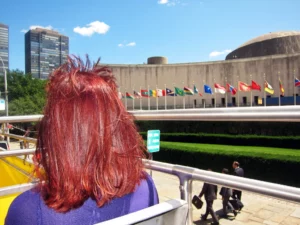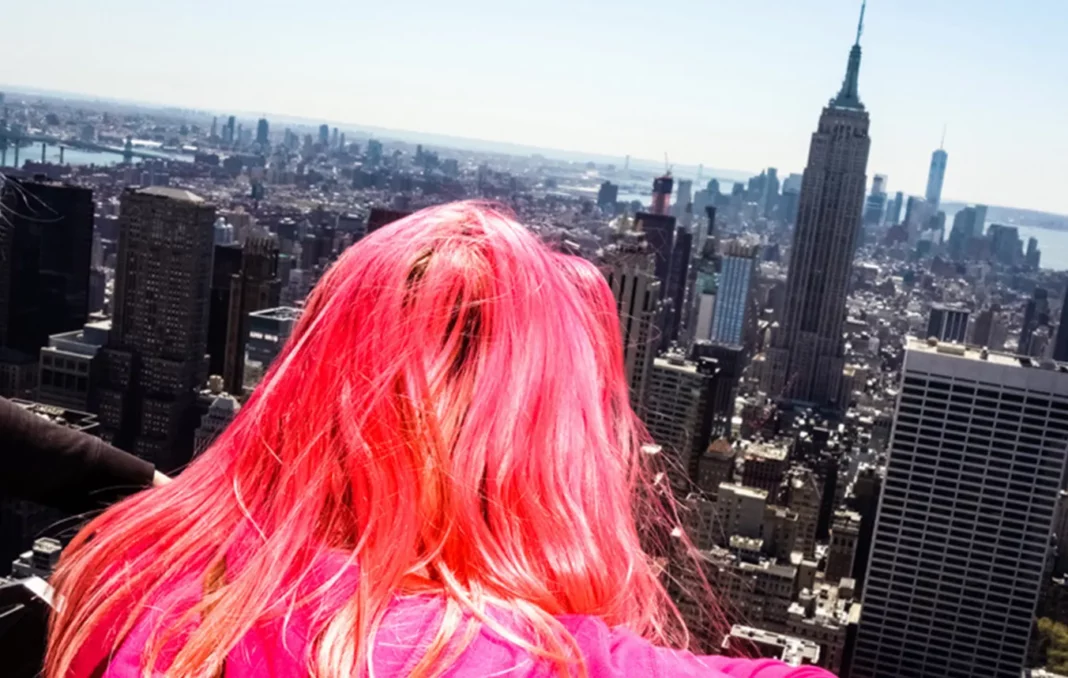Like many jaded New Yorkers, Dolly Faibyshev had stopped noticing her surroundings. The skyscrapers no longer impressed her and the bright lights no longer made her starry-eyed. The hustle and bustle that had once enlivened her had since become background noise. Fascinated by the energy and enthusiasm of tourists who visited the city each day, she decided to channel someone visiting it for the first time so she could reclaim that original sense of awe and wonder. Like every self-respecting first time tourist she visited all the must-see sights like the Empire State Building, Broadway, and the Statue of Liberty with a camera in hand.
Rather than a nuisance, tourists became a source of inspiration for Faibyshev. She embraced them as novices “whose energy she could feed and from whose untarnished perspectives she could learn.” From Faibyshev’s ventures as a tourist, her wildly successful photography project “I Love New York” was born. Adopting the perspective of someone new to the city enabled her to rediscover the joy of seeing it for the first time.

 Image: Dolly Faibyshev
Image: Dolly Faibyshev
Like Faibyshev, we are all vulnerable to habituation—the process of growing accustomed to our situation and surroundings. Novelty wears off; what is fresh grows stale; beauty no longer captivates. Essentially, we stop noticing what is around us. Of course, habituation can be a positive development. Thank goodness the strong smell of your co-worker’s cologne or the sound of a barking dog no longer bugs you. Apparently my dogs bark a lot but thanks to habituation, I no longer hear it. Yelping dogs aside, how do we resist habituating to positive experiences? How do we rediscover the joy and wonder of seeing something with fresh eyes?
To address this question, Associate Professor Clayton Critcher of Berkeley along with Minah Jung and Fausto Gonzalez from New York University, found that a relatively simple intervention can do the trick. Participants in their study who were asked to imagine an experience through somebody else’s eyes were able to recapture their original appreciation and stall the process of habituation. For example, in one of the experiments, participants were shown the same short video clip of a comedian doing standup. Predictably, ratings of how funny the clip was dropped with each successive viewing. However, the group that was asked to consider what somebody seeing the clip for the first time might see continued to find it funny.
Psychologists call this refreshing experience of seeing the world with fresh eyes the vicarious construal effect (VCE). Interestingly, VCE can even promote appreciation for experiences that people have no prior connection to or interest in. In one experiment, participants watched short clips of Japanese anime. A subset who admittedly had no interest in anime was asked to look for what an anime fan might enjoy about the clip. Adopting the perspective of a Japanese anime fan boosted participants’ appreciation of the clip. Fascinatingly, the result even held for an experiment that showed non-Spanish speaking participants a Spanish dubbed clip of the hit show, Friends. Those who were asked to consider what a Spanish-speaking fan might enjoy about the clip liked it more themselves. While I doubt this technique can be used to convince someone who doesn’t like horror movies or camping to suddenly become a convert, I do believe that it can open our minds.
“Simply trying to think about what someone else might see actually changes the way we see and interpret what we’re doing, changes the emotions we feel. It can help people to rediscover what they once saw in experiences they’ve had many times, or even help people to enjoy an experience that they weren’t initially predisposed to like.”
— Clayton Critcher
As a psychiatrist, I have found that the most effective way to help someone shift their emotional response to a given situation is not to dwell on trying to change their own mind but rather to try and understand someone else’s perspective. When we put ourselves in someone else’s shoes, as Dolly Faibyshev did, our thinking broadens and our world expands. Seeing things through someone else’s eyes gives us an opportunity to “re-see” our own experiences and capture appreciation for what we have lost or never had to begin with.
W.B. Yeats said, “The world is full of magic things, patiently waiting for our senses to grow sharper.” — Now you know how to sharpen your sense of wonder.
I wish you all the best,
Dr. Samantha Boardman






